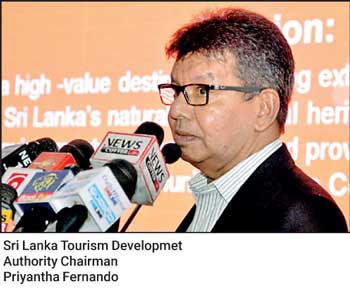Friday Dec 05, 2025
Friday Dec 05, 2025
Tuesday, 12 September 2023 01:32 - - {{hitsCtrl.values.hits}}
 By Charumini de Silva
By Charumini de Silva
Making an emphatic call for strategic reforms, Sri Lanka Tourism Development Authority Chairman, Priantha Fernando, stressed the pivotal role of a well-crafted aviation policy in realising the country’s ambitious goal of attracting 5 million tourists by 2029.
In June, the International Air Transport Association (IATA) in June also called on Sri Lanka to take steps towards creating an aviation blueprint that can lead to greater economic growth and prosperity through the development of a robust aviation industry.
Fernando noted a historic lack of synergy between tourism and aviation policies, highlighting the urgent need for a marketing-oriented approach to entice airlines and bolster inbound tourist traffic. “The harmonisation of aviation and tourism is paramount, leading to an open skies policy, eradicating all impediments to entice a greater number of airlines to operate into Sri Lanka,” Fernando told the Daily FT.
As Sri Lanka charts its course towards 5 million tourists, he said the call for a robust aviation policy resounds as a critical step in unlocking the country’s tourism potential.
He critiqued the decades-old aviation policy, which primarily shielded the national carrier, restricting Sri Lanka from fully capitalising on potential tourist markets. “On boosting and operating to points beyond, limitations were imposed making turnaround operations for some airlines not commercially viable,” he added.
Fernando emphasised the potential for heightened demand in specific markets, which remains untapped due to capacity constraints on direct flights into Sri Lanka. “While some generating points exhibit impressive load factors of 85-90%, these figures drop significantly upon arrival at Bandaranaike International Airport (BIA) to 45-50%. They distribute loads en route, particularly to the Middle East and intermediary points,” explained Fernando. He underscored the dwindling number of direct flights from Europe into Sri Lanka and identified Australia and Japan as emerging markets with untapped potential for direct tourist traffic.
“To achieve substantial growth, we must seriously contemplate augmenting seat capacities. Incentivising new airlines to operate into Sri Lanka and beyond is imperative; without incentives, investment remains uncertain,” Fernando said.
Over the past 15 months, eight airlines have recommenced their operations in Colombo, driven solely by commercial considerations due to high demand. However, Fernando stressed that this alone is insufficient, emphasising the pressing need for enhanced synergy and a comprehensive policy framework to revolutionise and sustain both industries.